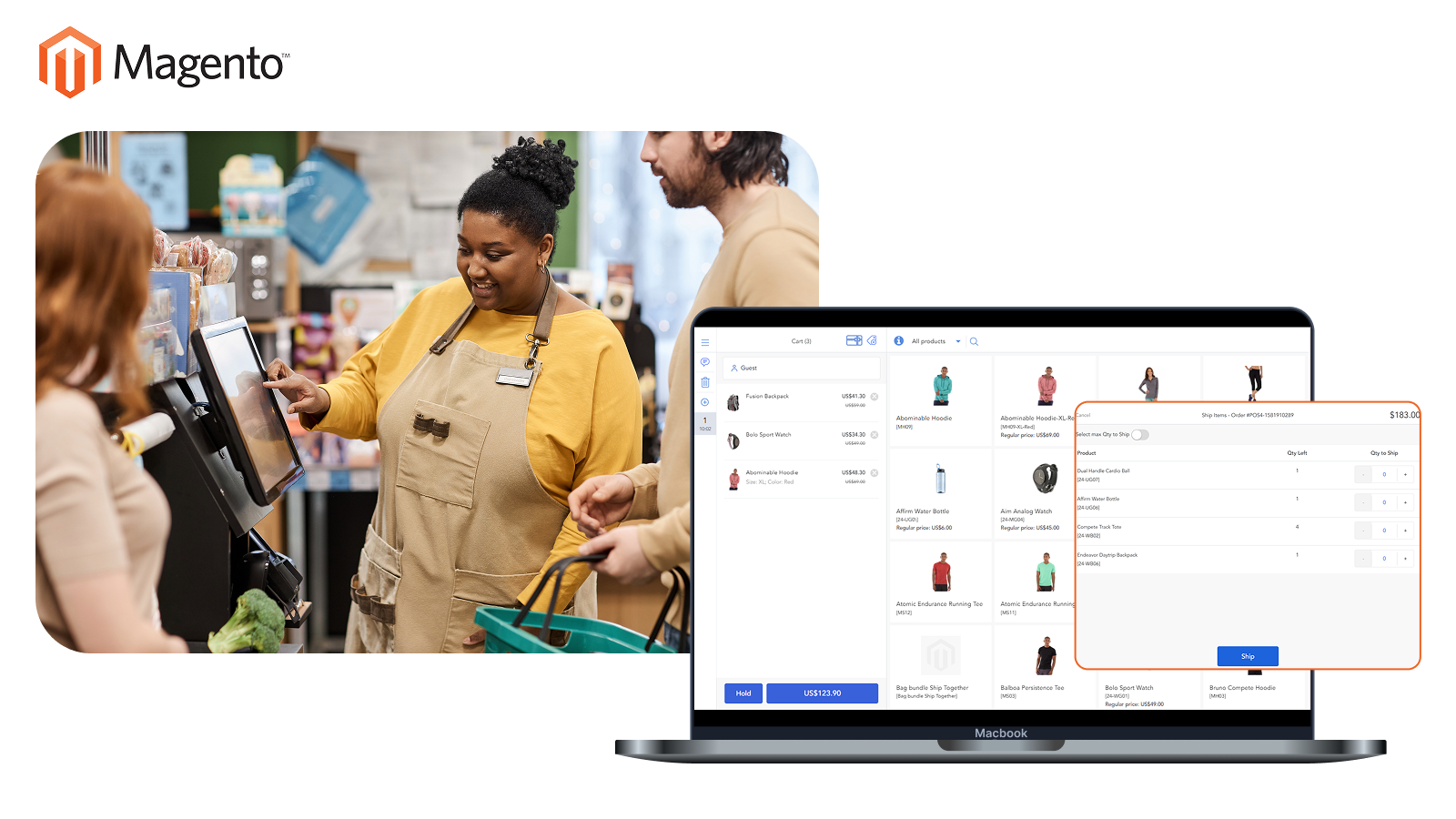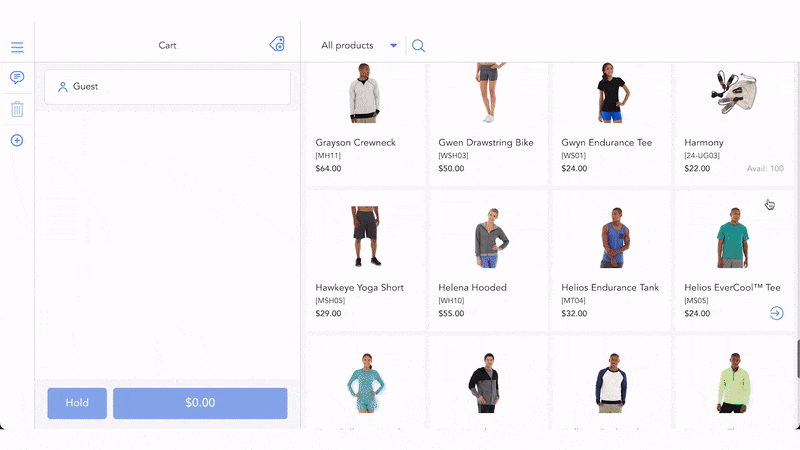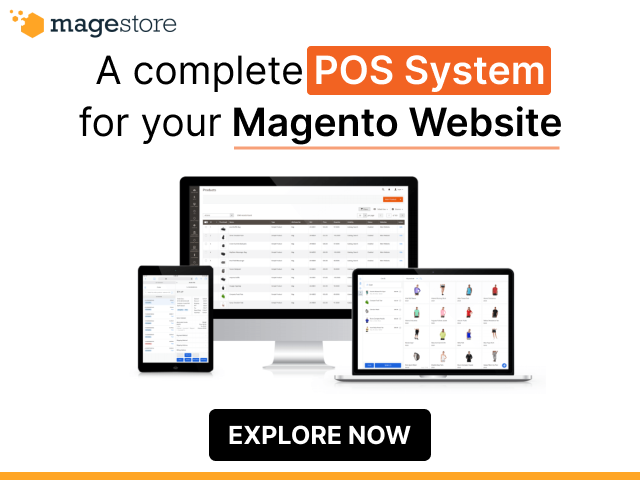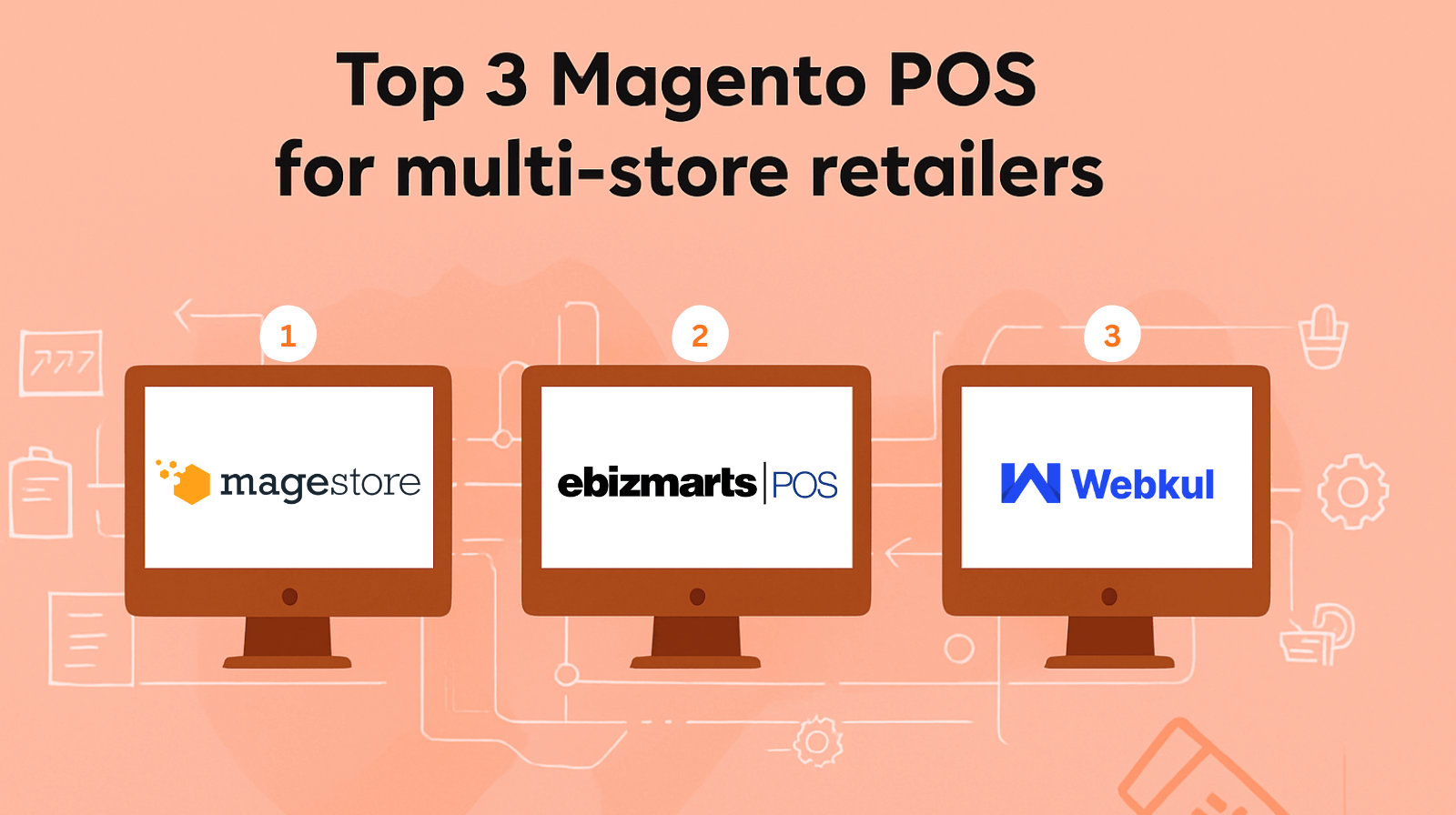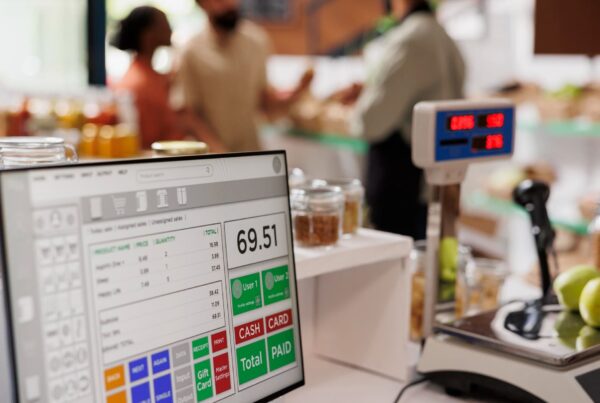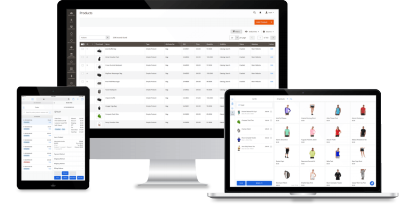“Magento POS is a point of sale system that integrates with the Magento. It allows merchants to process in-store checkout and shares all business data, such as sales orders, inventory, and customer information, with Magento.” – a clear and straightforward answer to the question What is Magento POS?.
However, it’s just a brief overview.
A Magento POS system is complex and has several components. Its workflow is also different from a typical point of sale system. To make matters more complicated, POS systems for Magento come in 2 types – native and non-native, each with pros and cons.
But if you approach it in the right way, a Magento POS system can ensure an accurate data sync between your online and physical stores and enable you to offer an omnichannel customer experience including BOPIS (Buy online pick up in-store) and omnichannel loyalty programs.
From a comprehensive definition of what a Magento POS is, the pros and cons of Magento-native and non-native POS, and the best POS systems in this category, here is everything you need to know before you pick out a Magento POS system for your business.
Key takeaways
- Magento POS is a point of sale system that integrates with Magento, allowing merchants to process in-store checkout and sync all sales data with the platform.
- There are two main types of Magento POS:
- Magento-native POS: Direct integration with Magento, built on Magento’s logic, no connector needed
- Standalone POS: No direct integration with Magento, a connector or middleware needed between the POS and Magento
- Key functions of a Magento POS system: In-store checkout with various payment methods, data sync with Magento, inventory management, customer management, employee management, loyalty programs, fulfillment, reporting, and more.
- A Magento POS system consists of two main components: POS hardware and POS software.
- Key factors to consider when choosing a Magento POS: Magento compatibility, core POS features, hardware compatibility, customization and scalability, budget, and quality of customer support.
- Recommended Magento-native POS solutions: Magestore POS, Acid POS, Webkul POS.
What is Magento POS?
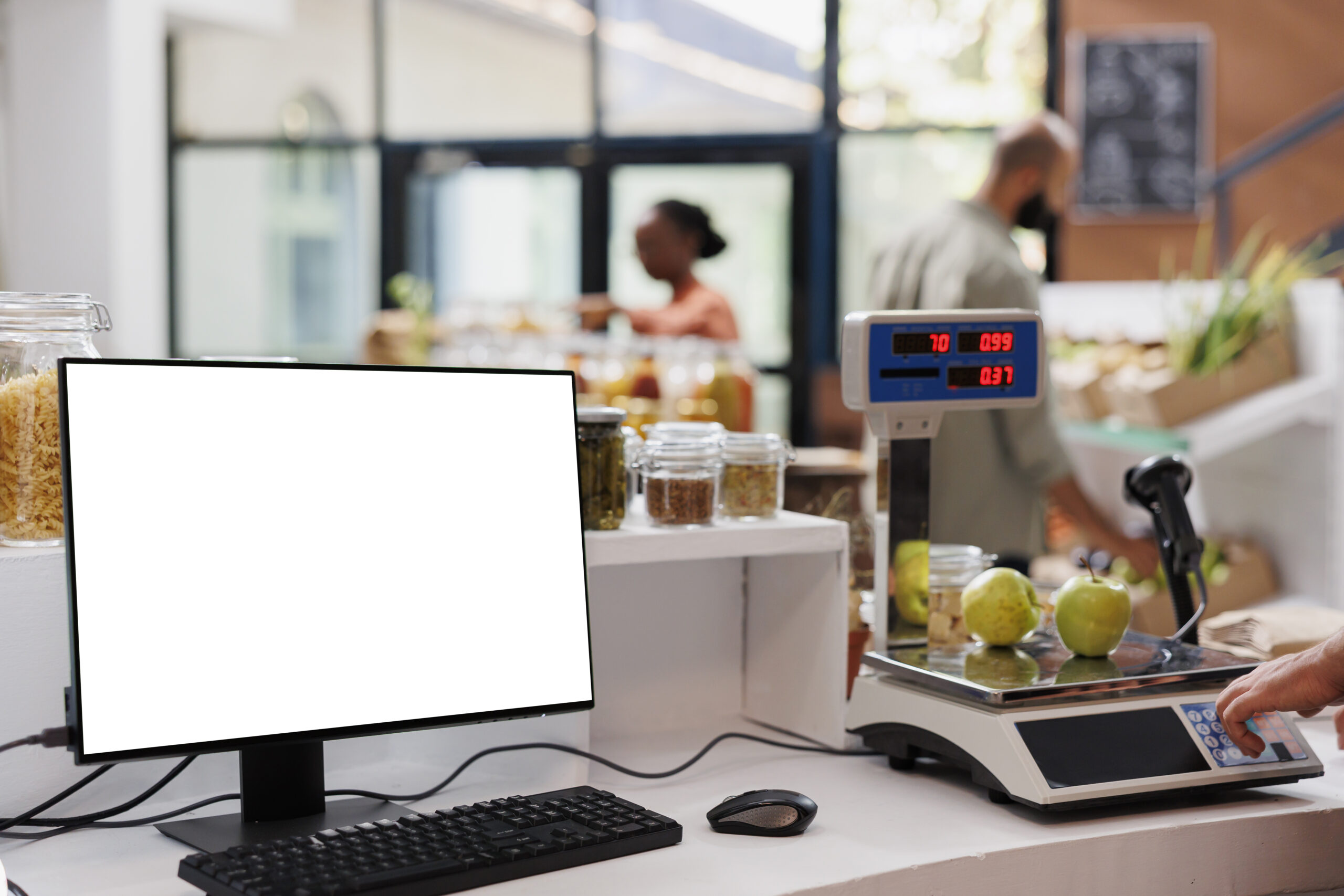
In more detail, Magento POS is a point of sale system that integrates with the Magento platform. It allows merchants to process in-store transactions and manage sales, inventory, order, and customer data across online and physical stores.
All store operational data – such as orders, inventory, or customer information – is synchronized in real time across channels, creating a single source of truth for omnichannel operations.
The smooth synchronization of data between online and physical stores enabled by a Magento point of sale system serves as a foundation on which businesses build an omnichannel customer experience. It lets you create a Magento loyalty program that works seamlessly across online and physical stores, enabling customers to earn and redeem points wherever they shop. You can also offer Magento 2 gift cards for convenient, cashless shopping. Additionally, the “click and collect” or “BOPIS” delivery method, which enables customers to order online and pick up their purchases at your store, is also available with a Magento POS.
Some key functionalities of a Magento POS system:
- Provide customers with a unified checkout experience across both your Magento online store and brick-and-mortar locations
- Support multiple payment methods such as cash, credit/ debit cards, mobile wallets, and gift cards
- Automatically sync and update data across channels: sales, orders, inventory, customer information, etc.
- Manage, process, and fulfill orders from multiple locations in a unified Magento order fulfillment system
- Build an omnichannel loyalty program: rewards points, store credits, gift cards, etc.
- Control inventory with SKU, barcode, and serial numbers
- Manage multiple warehouses in one centralized system
- Analyze reports on both Magento sales and in-store sales, inventory, and customer behavior
- Support normal operation when there is no internet connection with POS offline mode
What are the main types of Magento POS systems?
There are two main types of Magento POS systems.
- A Magento-native POS connects directly with the Magento platform and does not require a connector.
- A non-native Magento POS relies on a third-party connector because it does not integrate directly with Magento.
What is a Magento-native POS?
Magento native POS is a point of sale system built to be an integral part of the Magento platform. Using a native POS solution means you don’t need any connector or middleware to have Magento POS integration. All the data from the POS will be automatically synced in the Magento backend, ensuring the most accurate data synchronization and compatibility.
For example, Magestore POS is a Magento native point of sale system that uses the same database as the Magento platform and is built specifically to work with Magento. Powered by PWA technology, you can run this web POS on any desktop or tablet with a web browser.
What is a non-native Magento POS?
Non-native Magento POS, or a Magento standalone POS, is a point of sale system that operates independently with its own database. It means that if you want to integrate this POS system with the Magento platform, a connector or middleware is required to link the two systems and enable data synchronization.
On the market, there are some popular names of Magento standalone POS that you might have heard of, such as Lightspeed POS, Square POS, or Clover POS.
Comparison between a Magento native POS and a Magento non-native POS
To illustrate the key differences between Magento native and non-native POS systems, let’s compare Magestore POS, a typical example of a native solution, with Lightspeed POS, a popular non-native option.
This comparison will highlight how their integration with Magento impacts factors like data synchronization, functionalities, cost types, and overall performance.
Criteria | Magestore POS (A Magento native POS) | Lightspeed POS (A Magento non-native POS) |
#DATA SYNCHRONIZATION | ||
Inventory/ Stock | Yes | Yes Frequent inventory synchronization issues |
Sales orders | Yes | Yes |
Purchase orders | Yes | No |
Customer information | Yes | Yes |
Invoice | Yes | No Manually record payment for the invoice in the POS |
Unified product prices across channels | Yes | No |
Synchronization frequency | Real-time, accurate | Approx. 5 minutes, potential for delays |
Database | Unified (Magento's database) | Separate databases |
Risk of data discrepancy | Low | High |
Performance dependency | Magento platform | Magento platform and connector |
#OTHER FUNCTIONS | ||
Omnichannel loyalty program | Yes Built-in loyalty program. Run the same loyalty programs online and in-store | No The in-store loyalty program differs from the website because they are not connected |
Reports and analytics | Yes | Yes |
Omnichannel fulfillment option: Click-and-collect | Yes | No |
#INTEGRATION | ||
Connector | Built-in, no connector needed. Direct data synchronization to the Magento backend | A third-party connector needed for POS and Magento integration (E.g. Maurisource) |
Payment processor | Open to integrate with local payments based on country/ region | Lightspeed Payments Penalty fees for using third-party payments |
Integration with other third-party solutions (ERP, CRM, Accounting, etc.) | Yes | Yes |
#COST | ||
Magento pricing plans | Yes | Yes |
POS system registration fee | Yes One-time payment to get a lifetime license | Monthly subscription fees Yes |
Connector fee to integrate POS with Magento | No | Yes |
Development cost for additional functions or features | Yes | Yes |
Payment processing fee | Yes (Charged by the payment processor, not the POS provider) | Yes |
>>> Might you like: eCommerce POS integration: Connect online and offline sales in 2025
Key finding: Magento native POS offers direct integration with Magento compared to a non-native solution, as it is built as an integral part of the platform. Using a non-native POS may involve additional costs related to the connector, such as setup fees, ongoing subscription or licensing charges, and potential maintenance or support expenses.
Which components are included in Magento POS?
A Magento POS system consists of two main parts: POS hardware and POS software. For a general understanding, POS hardware refers to the physical equipment serving the transaction process and other interaction activities with customers in the store.
Meanwhile, POS software is the application or program that works with POS hardware to manage sales transactions and other business operations.
Magento POS hardware
Hardware compatibility in a POS system refers to the integration between POS software and its associated hardware peripherals.
This compatibility depends on several factors. For example, peripherals designed to function on browsers are suitable for web-based POS systems, while those compatible with apps work well with app-based POS solutions. In some cases, these peripherals can connect instantly to the POS system without requiring any customization, however, others may need additional setup or adjustments.
While there is a wide range of hardware working with Magento POS to run a brick-and-mortar store, we focus on some key tools and accessories typically required to process in-store transactions.
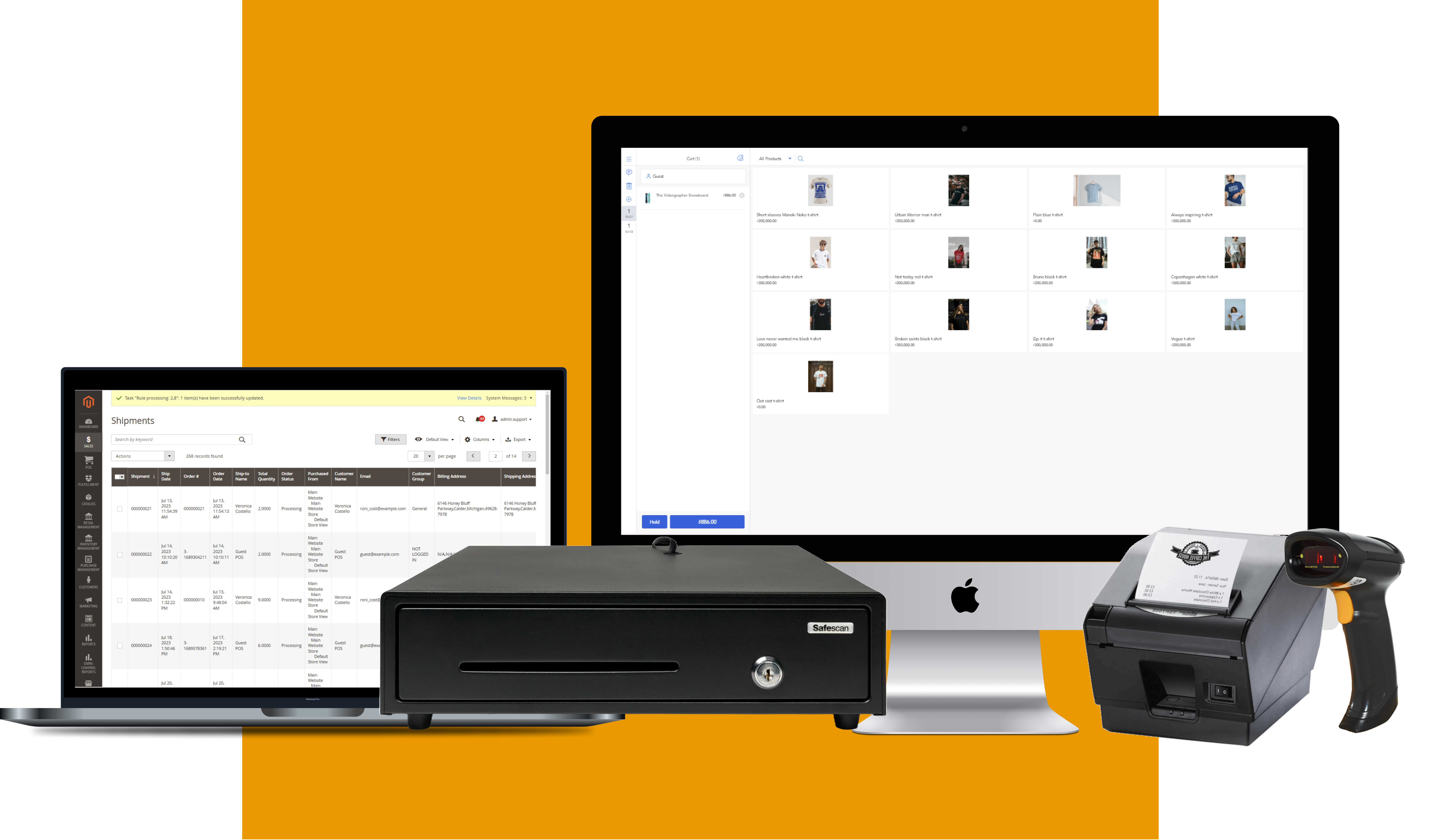
A Magento POS system requires specific hardware to process in-store transactions, such as a POS terminal, barcode scanner, receipt printer, and cash drawer.
POS terminal
A POS terminal is a hardware device used to process transactions at checkout. These terminals come in various types, from traditional countertops equipped with keypads, display screens, and card readers, to portable devices like mobile or tablet terminals running a POS app paired with a card reader. These diverse types provide the flexibility to choose the one best suited to your business model.
For businesses with fixed locations, such as grocery stores or full-service restaurants, a stable and fixed countertop is well-suited. On the other hand, for businesses that require lightweight and mobile solutions, such as food trucks or pop-up shops, a mobile or tablet POS terminal might be a better fit.
Barcode scanner
A barcode scanner is a device that captures product information and sends the data to the Magento POS by scanning the barcode printed on the product. It fastens the checkout and inventory tracking process by avoiding manually entering the product information.
Some popular types of barcode scanners on the market are pen barcode readers, laser barcode scanners, Charge-Coupled Device (CCD) barcode scanners, and Imager/Camera-based barcode scanners.
Card reader
A card reader is a device that can decode the debit and credit card information stored in a microchip or a magnetic stripe of the cards to accept payments. Some data that a card reader decodes from the card are cardholder information, account number, authorization code, or card expiration date. The card reader will transfer this information to the payment processors to review and authorize the transaction.
>>> Might you like: Top credit card readers for retailers
Receipt printer
Some merchants have the habit of keeping receipts as purchase records to track expenses or facilitate returns and exchanges. Or in case the card transactions require a physical signature, a paper receipt becomes essential. In such situations, a receipt printer handles the task of printing paper receipts for customers after transactions.
Many Magento POS systems, like Magestore POS, let you tailor receipts to your specific needs. You can promote your brand identity to the customers by adding a logo or showing business contact information. Adding a thank-you note at the end of the receipt or highlighting specific customer details related to their purchase are also effective ways to improve the customer experience.
>>> Might you like: 5 steps to set up printer for your ideal POS receipt
Cash drawer
A cash drawer is a secure compartment typically found under the cash register or POS. It is designed to store cash, coins, receipts, and other paperwork. A manual cash drawer requires a manual key to open and close. Meanwhile, a cash drawer connected to the Magento POS can automatically open when a cash payment is processed.
Balancing the cash drawer is also an essential business task, however, you can speed up this procedure by using data from your POS terminal.
Other peripherals
In addition to the above-mentioned hardware commonly required in a Magento POS system to process transactions, there are other peripherals designed to enhance in-store customer interactions. Some of them are customer displays, scales, signature pads, self-service kiosks, barcode printers, fingerprint scanners, and more.
Magento POS software
While the POS hardware serves as the physical interface for a POS system, the Magento POS software is the brain behind the operation. It is the digital engine that powers transaction processing, data management, inventory control, and more. The specific functionalities you utilize within the software will largely depend on your unique business requirements.
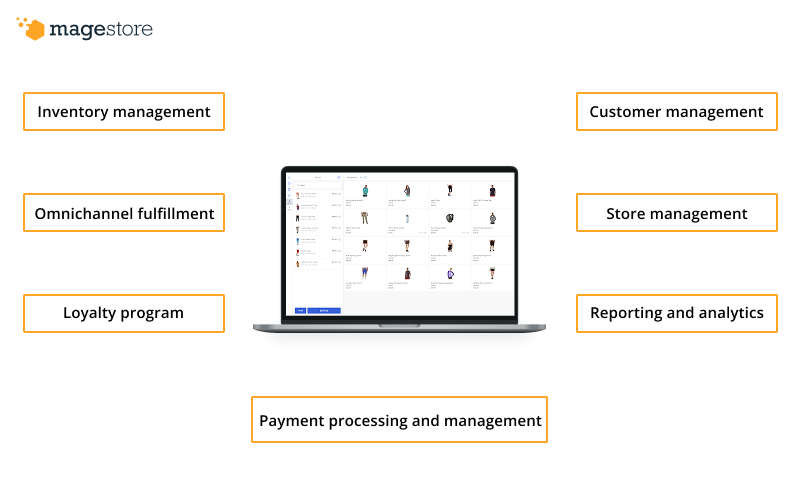
Magento POS software supports payment processing, inventory management, order fulfillment, loyalty programs, customer management, reporting, and more.
Payment processing and management
While most of the heavy lifting in payment processing is handled by the payment processor, Magento POS plays its part in facilitating in-store payment by communicating with the card reader to initiate payment taking and receiving transaction status from the reader.
It then stores transaction details, such as the transaction ID and the last few digits of cards, for reconciliation and reporting, in both online and physical stores.
The POS enables the set up of multiple payment methods, for example, cash, credit and debit cards, mobile wallets, bank transfers, checks, etc.
- When evaluating a Magento POS solution, you should check which payment processors it supports. Some systems only work with their own built-in payment services, which can restrict your options and create limitations for your business. To avoid this lock-in, it’s better to choose a POS that integrates with multiple processors. For example, Magestore POS is payment-agnostic and works with a wide range of payment providers, giving you the flexibility to use the payment solutions that best suit your business.
Inventory management
Efficient Magento inventory management is crucial for any business, particularly those operating multiple stores. Magento native POS shares the same inventory database with Magento, while other standalone POS (Magento non-native POS) have their own inventory systems and require data syncing with Magento via connectors.
When sales occur, the Magento POS system automatically updates the inventory level, providing up-to-date stock data across locations. This system can also be configured to send notifications or alerts when the stock level of specific items reaches a predefined low level, reducing stockouts and ensuring timely reordering.
With an overview of the entire product volume, it can generate valuable insights into sales trends, best-selling and slow-moving products, etc. From these insights, you can define the next steps for your sales strategies and make more informed, data-driven decisions.
Omnichannel fulfillment
Click and collect, curbside pickup, or buy online and pay at stores, are some omnichannel fulfillment options that provide customers with flexible ways to shop. A Magento native POS can easily implement these solutions due to its seamless integration with Magento’s backend. As a result, these fulfillment options are commonly built-in and readily available in Magento native POS systems.
For non-native solutions, it might require some extra effort to develop and configure these fulfillment options.
Loyalty program
Rewarding customers with points, discounts, or exclusive offers is a proven strategy to boost customer retention and increase repeat purchases. Some Magento native POS allow you to build loyalty programs by creating discount codes using Magento shopping cart rules, applying coupon codes to entire carts in person, adding custom discounts for the whole cart, setting custom prices for individual items, building store credit policy, and more. These promotional rules can be seamlessly applied across both online and offline stores.
On the other hand, some non-native POS solutions may lack integration for loyalty programs between online and offline stores, leading to potential inconsistencies in promotional applications.
>>> Might you like: The rise of omnichannel loyalty programs
Customer management
A Magento POS system collects and stores customer information, like contact details, purchase history, or preferences. From these data, you can build stronger relationships with your customers by providing personalized communication or targeted promotions. It encourages customers to come back to your store and make purchase decisions.
Not at all, with saved customer information in the system, the checkout process is also faster
Staff management
There is a wide range of capabilities a merchant can do in managing staff within a Magento POS system: creating schedules (such as shifts, time-off requests, and overtime), tracking clock-in and clock-out times, assigning role-based access and permissions, monitoring staff performance, and more. These functionalities help streamline operations and improve workforce efficiency.
Reporting and analytics
Based on the data stored in the system, a Magento POS provides merchants with various types of reporting and analytics. With real-time insights into business performance, you can make informed decisions that drive growth and improve operations.
Some types of reports that a POS Magento can deliver:
- Sales report: Track daily, weekly, and monthly sales of the store
- Product performance: Report on sales by product, brand, and supplier to identify trends and make the best decisions
- Staff performance: Monitor a staff’s sales on a daily, weekly, and monthly basis
- Inventory report: Track current stock levels, monitor inventory movement, etc.
- End-of-Day report: Review daily X-Report & Z-Report, confirm payments, and timely spot any errors
-
Of course, the available reports depend on the POS system you use and the plan you select.
Key finding: For a Magento POS system to function effectively, both software and hardware are essential. The software integrates with Magento to manage data, inventory, and customer information, while the hardware enables the physical processing of payments in-store.
How does a Magento POS work?
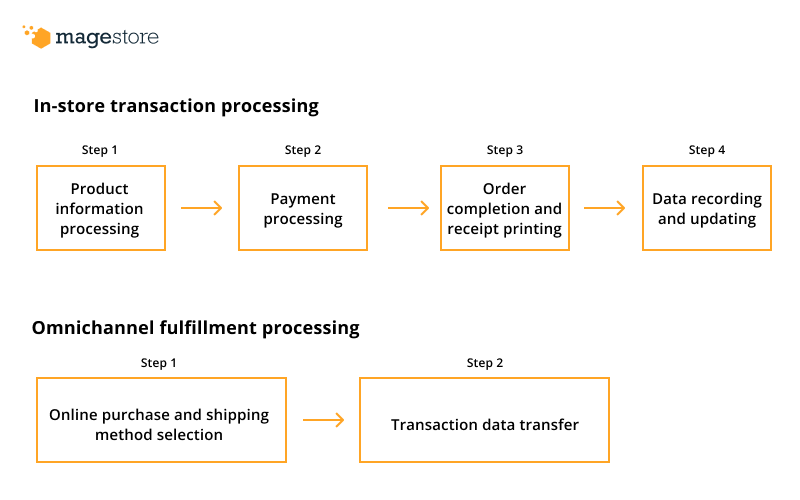
Magento POS workflow during a transaction
Simply understand the workflow of a Magento POS system during a transaction by following the step-by-step process outlined below.
In-store transaction processing
Process | The cashier | Magento native POS | Magento non-native POS |
Step 1: Product information processing |
|
All the discounts, coupons, or promotions are linked between both online and offline stores. |
Discounts, coupons, and promotions may not be synchronized across online and offline channels, requiring staff to manage them manually. |
Step 2: Payment processing |
|
| |
Step 3: Order completion and receipt printing |
|
| |
Step 4: Data recording and updating |
|
| |
Omnichannel fulfillment processing
Process | Customer | Magento native POS | Magento non-native POS |
Step 1: Online purchase and shipping method selection |
| ||
Step 2: Transaction data transfer |
|
Some non-native POS systems require customization to enable these data transfers, while others may not support these functions at all. In such cases, staff must manually check and manage the information. |
How to choose a suitable POS system for Magento
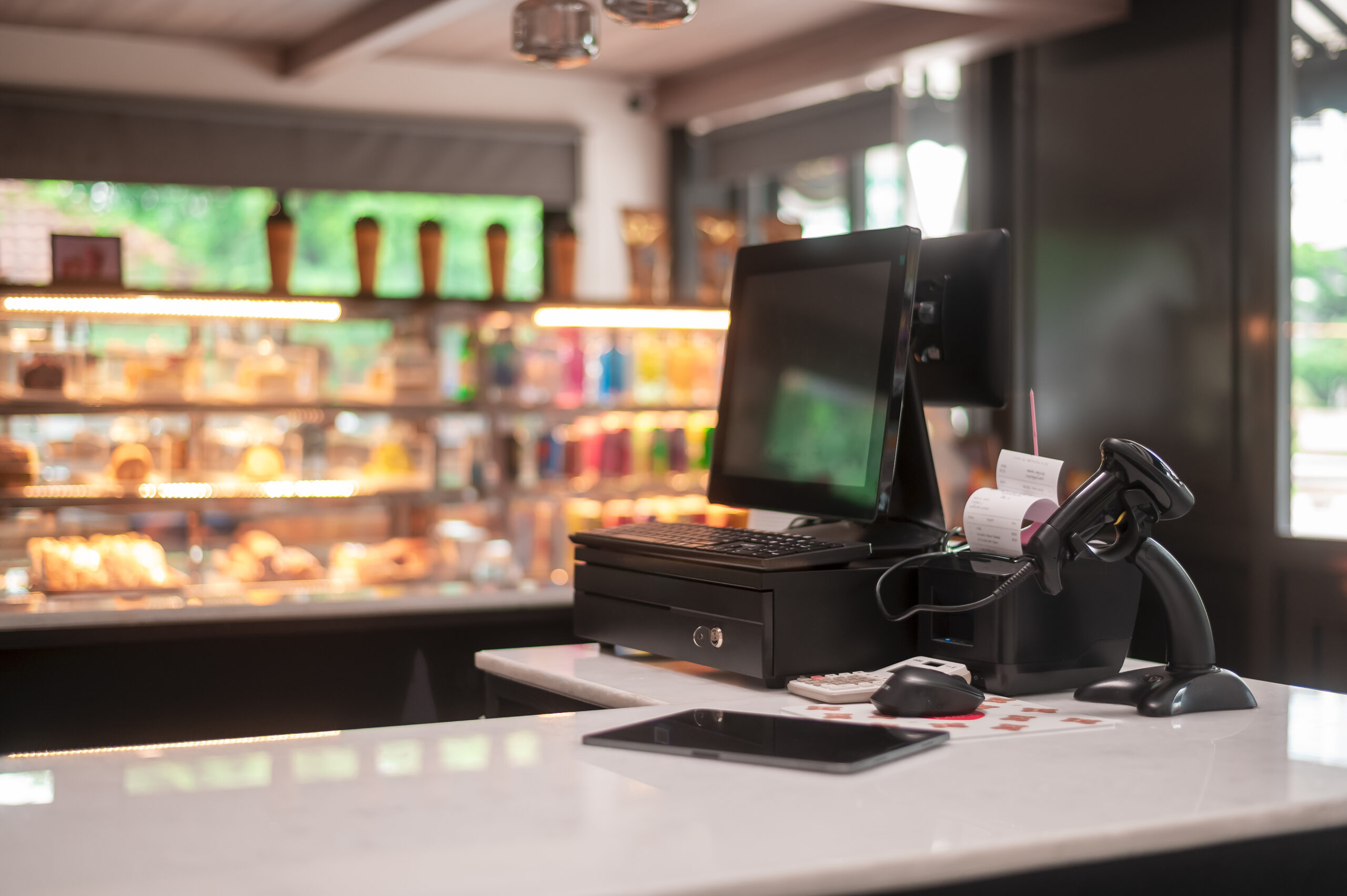
1. Ensure seamless Magento compatibility
Before choosing a Magento POS, you must verify its compatibility level with Magento. As mentioned above, there are two types of Magento POS that you can use: Magento native POS and Magento non-native POS.
For accurate and real-time data synchronization, a Magento native POS is often the superior choice, as it directly syncs the data into the Magento backend. If you use a Magento non-native POS, make sure that you choose a reliable connector vendor to eliminate the data syncing issues.
Some POS systems may have specific requirements for the Magento version, so be sure to pay attention to this detail. For instance, select Magento 2 POS if using Magento 2.
2. Evaluate POS core features that you need
It is essential to select a POS Magento that can adapt to your business requirements. Carefully evaluate the core features and functionalities of the POS that are most important to your business. For example, the ability to quickly process transactions with various payment methods; real-time data synchronization for accurate inventory and sales tracking; seamless integration with other essential business tools (ERP, CRM, accounting software, etc.); or robust reporting and analytics capabilities to gain valuable insights into your business performance.
Additionally, selecting an industry-specific POS is an effective way to ensure you have the most suitable solution for your business, as it offers a comprehensive set of features tailored to meet the unique needs of your industry. For example, Toast POS for restaurants or Magestore POS for retail businesses.
3. Ensure hardware compatibility
POS systems can be designed for desktops or mobile devices. Some only run on desktop hardware, while others are built exclusively for mobile use. A web POS like Magestore POS offers greater flexibility, as it can run on any device with a web browser, whether it’s a desktop or tablet.
If you already have a hardware kit or have set a budget for hardware, ensure you choose a POS system that is compatible with your existing or planned equipment.
4. Check the ability of customization and scalability
If you have a plan to expand your business in the future, for example, opening more store locations or increasing product lines, consider selecting a POS system that can adapt and grow with your business.
As your business grows, your requirements may become more complex, leading to the essential of customization. In such cases, a custom POS is well worth considering to meet your evolving requirements effectively.
5. Evaluate your budget spending
It’s crucial to be mindful of your budget when selecting a Magento POS system for your business and choose one that aligns with your financial plan. Here are some common Magento POS fees to consider:
- Initial setup fee: Costs for Magento POS system installation and configuration
- Connector fee: Fees charged by the connector vendor if you choose to use a non-native POS
- Subscription or one-time license fee: Recurring POS system charges or one-time payment for ownership
- Payment processing fee: Per transaction charges applied by payment processors you choose to use
- Integration or add-on feature/ extension fees: Costs for connecting the Magento POS system with other systems or enabling additional functions
- Maintenance and support fee: Expense for technical support and system updates
- Hardware costs: Purchasing or leasing expenses for terminals, scanners, printers, and other peripherals
-
Thoroughly evaluate and compare the pricing plans and associated fees of each POS system before making any commitment. Some POS vendors are open to negotiating fees, especially if you have high transaction volumes or are willing to sign a long-term contract.
6. Seek POS vendors providing reliable support
Look for a POS vendor with a responsive customer support team to assist with any technical issues or questions. To gain insights into their service quality, consider reading customer reviews in forums for a general evaluation.
Summary: Some main factors in choosing a Magento POS system include Magento compatibility, core POS features, hardware support, customization options, budget, and vendor support. Since every business has unique workflows and requirements, it’s essential to evaluate these considerations carefully to identify the solution that best fits your needs.
Which Magento POS systems are available?
So, what are the best POS systems for Magento? While we’ve outlined some key criteria above to help you select the right option for your business, here are a few Magento point of sale recommendations for your consideration.
Magento POS | Pros | Cons | |
Magento native POS | Magestore Magento native POS |
|
|
Webkul Magento native POS |
|
| |
Acid Magento native POS |
|
| |
Magefan Magento native POS |
|
| |
Magento non-native POS | Lightspeed standalone POS |
|
|
Square standalone POS |
|
| |
>>> Might you like:
>>> Other useful POS knowledge:
How Magento-native POS architecture improves sync reliability and data accuracy
Amasty POS in development: 5 ready-to-use Magento POS to consider
FAQs about Magento POS
Question 1: Who needs Magento POS?
Magento POS is ideal for businesses that operate both an online Magento store and physical locations, and need all data (sales, inventory, and customer information) to stay synchronized and consistent across channels.
Question 2: What is Magento used for?
Magento is an eCommerce platform designed to build and manage online stores. Built on open-source technology, Magento is highly customizable and scalable to match merchants’ needs.
Question 3: What is Magento payment service?
Magento doesn’t have its own dedicated “payment service” in the way some platforms might. However, Magento can integrate with multiple payment gateways to process payments.
Question 4: What is Magento service?
Magento services that Magento vendors offer to merchants: online store development, customization, and optimization; ongoing support and maintenance; migration from other platforms to Magento; business consulting and strategy; etc.
Question 5: What are Magento data entry services?
Magento data entry service refers to the process of inputting data into the Magento store or migrating the data from other eCommerce platforms to Magento. These data can be product information, customer data, inventory updates, order details, shipping information, marketing data, and more.
Question 6: What is POS in eCommerce?
A POS, or Point of Sale, is a system that includes hardware and software to process payments and complete customer purchases. POS transactions can occur in both online and offline stores, with all sales data synchronized in a single system. This provides merchants with a unified solution to efficiently manage omnichannel business operations.
Question 7: How much is the price of Magestore Magento POS?
Magestore offers 3 flexible pricing plans for the Magento POS:
- POS Lite: $69/month (Subscription)
- POS Commerce: Custom pricing, one-time payment
- POS Customization: Custom pricing, one-time payment
Your business requirements, scale, and expected level of support and services will decide the final amount you’ll need to pay. Adding new locations, users, and devices won’t cost you anything, thus saving you a lof of money for expansion.
Question 8: What are Magento 2 POS extensions?
Magento 2 POS extensions are add-ons or modules that can integrate with Magento 2 POS system to enhance its functionality. Businesses select and configure these extensions based on their specific business needs, such as inventory management enhancements, CRM integrations, advanced reports and analytics, omnichannel features, etc.
Question 9: How to start using a Magento POS?
To get started with a Magento POS, begin by selecting a solution that aligns with your business needs. Vendors like Magestore offer an experienced support team to guide you through the setup process and help you quickly start using the Magento POS system.
